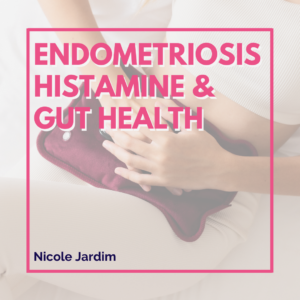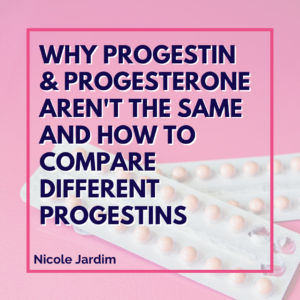Maybe you’ve heard of premenstrual syndrome (PMS) before…?
Who am I kidding, of course, you have!
Something like 75% of the female population is estimated to be affected by PMS. That means most of us are familiar with the mood swings, cravings, bloating, breast tenderness and general misery our monthly cycles can bring when our hormones are hopelessly out of balance.
But as I describe in my book, Fix Your Period, there’s a bigger, badder sister to PMS — and she’s called premenstrual dysphoric disorder, or PMDD.
For the 3-8% of the population that experiences this monster, it’s legitimately no fun.
In the 7-14 days that lead up to a woman’s period, she is completely overwhelmed by an extreme form of PMS. This is a disorder that affects quality of life to the point that career and relationships suffer big time. She winds up feeling so terrible each month that she actually loses years of her life to this menace.
What Is PMDD?
So, PMDD is kind of like PMS but on a much grander scale.
It’s actually classified as a psychiatric disorder in the Diagnostic and Statistical Manual of Mental Disorders (DSM-5) — which, in my opinion, helps contribute to the narrative that women are “crazy” at that time of the month. Let it be known: if you’re suffering from PMS or PMDD — you are NOT crazy, don’t let anyone treat you like you are!
However, the fact that PMDD is treated by traditional medicine as a mental disorder does highlight the typically mood-related symptoms that women with PMDD experience.
Symptoms like:
- Depression
- Hopelessness
- Feelings of low self-worth
- Tearfulness
- Anger (especially extreme bursts of anger that feel uncontrollable)
- Anxiety
- Irritability
- Fearfulness
- Feeling completely overwhelmed
- Lack of interest in usual joyful activities
- Suicidal thoughts
Some of the other hallmark symptoms of PMDD include:
- Insomnia
- Extreme fatigue and sleepiness
- Food cravings (that often result in binge eating)
- Breast tenderness
- Headaches or migraines
- General lack of energy
- Joint pain
- Weight gain
- Trouble concentrating
- Cramps
- Bloating
Getting a PMDD Diagnosis
In order for a woman to be officially diagnosed with PMDD by a doctor, she would typically need to keep a diary of her symptoms over a few months to determine whether her symptoms appear cyclically.
According to the DSM-5, “at least 5 of the following 11 symptoms (including at least 1 of the first 4 listed) should be present for diagnosis.
- Markedly depressed mood, feelings of hopelessness, or self-deprecating thoughts
- Marked anxiety, tension, feelings of being “keyed up” or “on edge”
- Marked affective lability
- Persistent and marked anger or irritability or increased interpersonal conflicts
- Decreased interest in usual activities (eg, work, school, friends, and hobbies)
- Subjective sense of difficulty in concentrating
- Lethargy, easy fatigability, or marked lack of energy
- Marked change in appetite, overeating, or specific food cravings
- Hypersomnia or insomnia
- A subjective sense of being overwhelmed or out of control
- Other physical symptoms, such as breast tenderness or swelling, headaches, joint or muscle pain, a sensation of bloating, or weight gain.”
And they would need to be present a week or more before the person’s period, resolving when her period starts:
PMS vs. PMDD: What’s the difference?
Just to be clear, a woman experiencing PMDD has a really difficult time functioning in her normal life — she’s not just a little bit uncomfortable.
Sure, PMS can be a bear and isn’t fun.
But PMDD means that symptoms are severe and they last for much longer than PMS. PMS typically rears its ugly head a few days to a week before your period starts. And PMDD can hit a full 7-14 days before.
While PMS may cause you to snap at a loved one, PMDD causes full-on episodes of anger that often leave women with massive relationship issues that sometimes can’t be repaired.
Women with PMDD often have to rearrange their lives and work to accommodate their monthly struggles.
The symptoms of PMDD are more severe and significant than garden-variety PMS. A PMS sufferer may get anxiety or feel depressed, but a woman with PMDD gets extreme anxiety and may wrestle with suicidal thoughts.
What Causes PMDD?
Just like with PMS, PMDD is often rooted in inflammation and high levels of estrogen circulating throughout the body.
This is why I’ve dedicated my life to helping women learn how to leverage their body’s natural ability to detox and reduce inflammation.
When we stabilize blood sugar, focus on improving gut health, and support the liver’s ability to detox estrogen, miracles can and do happen! I’ve seen it time and again in my Fix Your Period Programs.
Allopregnanolone And GABA
Aside from estrogen and inflammation, another reason that some women experience PMDD is actually a byproduct of progesterone.
You see, progesterone usually creates a magnificent calming effect in the body, as it’s converted to the neurosteroid allopregnanolone — which *typically* helps to soothe the Gamma-aminobutyric acid (GABA) receptors in the brain.
But for PMDD sufferers, it seems that sometimes allopregnanolone doesn’t quite work as it should. It aggravates the GABA receptors and instead of feeling chill, women with PMDD feel anxious, moody, irritable and angry.
Histamine Intolerance
Another tricky reason some women experience PMDD is histamine intolerance.
Histamines are the compounds that we typically think of when we think of allergic reactions — like hives or hay fever.
But histamine can actually be a driver of the inflammation that causes PMDD. And since it’s actually critical for ovulation, it circulates throughout the reproductive cycle. The problem arises when women have histamine intolerance and likely don’t realize it. Or, possibly they have mast cell activation syndrome (MCAS) and their mast cells are making extra histamine.
Histamine may also affect the GABA receptors in the brain, which could be another reason it triggers PMDD.
If you’re experiencing some of the following symptoms, your PMDD or PMS could be tied to histamines:
- Headaches or migraines around ovulation and/or just before your period
- PMS type symptoms — anxiety, low mood, etc. around ovulation
- Painful periods
- Painful breasts
- Itching or skin aggravation
Genetic Sensitivity
Since women with PMDD typically have “normal” levels of hormones in their blood, researchers have recently suggested that PMDD is an abnormal response to normal hormones.
One study showed that women with PMDD have a genetic predisposition to this phenomenon, indicating that those with PMDD have a different molecular structure that creates the response to hormones.
Of course, this should help expand the narrative that women aren’t just crazy, that there’s something that physically explains some of these symptoms…but it also doesn’t mean that if you do suffer from PMDD that you’re fated to because of your genes.
Luteal Phase Inflammation
One last point I want to bring up that builds on what I just mentioned, is the fact that depression is strongly correlated with dysregulated gut and immune function, and runaway inflammation. While PMDD isn’t run of the mill depression, the luteal phase is associated with increased pro-inflammatory molecules and thus increased inflammation, compared to the follicular phase. To back this up, there is also some research that shows that women with premenstrual symptoms have increased pro-inflammatory markers compared to those without premenstrual symptoms.
This is a potent reminder that our genetics are not the only determining factor for our health outcomes. Just like PCOS and endometriosis, there may be underlying genetic components to PMDD, but it’s really our environment that determines so much of how we feel.
What is most promising is that generally speaking, many of the solutions to these problems are straightforward and can literally change your life if you have PMDD.
What Are The Treatment Options For PMDD?
Luckily, there is hope if you’re suffering from PMDD.
Of course, traditional medicine would suggest treatment with selective serotonin reuptake inhibitors (SSRI) — aka antidepressants to treat the mood components of this disorder. And they would likely suggest hormonal contraception as a means to “regulate the hormonal cycle” and prevent ovulation.
Obviously, if that’s the route you need to take, no judgment here. PMDD can be a life-disrupting and miserable disorder, one that many women spend years trying to combat.
Some other, more natural approaches to consider:
- Balancing blood sugar
- Reducing inflammation
- Prioritize sleep and addressing your stress in a meaningful way
- Supporting gut health – histamine problems stem from gut dysbiosis
- Encouraging proper liver detoxification
- Cutting out histamine rich foods from your diet
- Taking natural antihistamines like vitamin C and quercetin
- Adding in magnesium and Vitamin B6 from foods and/or supplements
I go over all of these strategies and more in-depth in my book Fix Your Period. If you want to get in on the fun, be sure to check it out HERE.
Let’s Put An End To PMDD And PMS
If you’re experiencing PMDD or PMS, know that relief is possible. Know that what you’re experiencing isn’t just “what women have to put up with every month.”
If you’ve tried everything, and you still can’t seem to figure out how to get a handle on your symptoms, take my completely free quiz and let’s evaluate what’s going on. Chances are you need more specific guidance on how to get your endocrine system working for you. I’d love to help point you in the right direction!
Sources
“Premenstrual dysphoric disorder: burden of illness and … – NCBI.” https://www.ncbi.nlm.nih.gov/pmc/articles/PMC2440788/.
“The Association of Inflammation with … – NCBI – NIH.” 1 Sep. 2016, https://www.ncbi.nlm.nih.gov/pmc/articles/PMC5311461/.
“There is increasing evidence to suggest that brain … – NCBI.” https://www.ncbi.nlm.nih.gov/pubmed/31630609.
“(PMS) and premenstrual dysphoric disorder (PMDD) – UpToDate.” 12 Feb. 2019, https://www.uptodate.com/contents/premenstrual-syndrome-pms-and-premenstrual-dysphoric-disorder-pmdd-beyond-the-basics.
“Reduction of quality-adjusted life years (QALYs) in … – NCBI.” 3 Jul. 2017, https://www.ncbi.nlm.nih.gov/pubmed/28674766.
“Tolerance to allopregnanolone with focus on the GABA … – NCBI.” https://www.ncbi.nlm.nih.gov/pmc/articles/PMC3031054/.
“[Histamine receptors in the female reproductive system … – NCBI.” https://www.ncbi.nlm.nih.gov/pubmed/12369286.
“Histamine Action on Vertebrate GABAA Receptors – Journal of ….” 18 Apr. 2008, https://www.jbc.org/content/283/16/10470.full.
“The ESC/E(Z) complex, an effector of response to … – Nature.” 3 Jan. 2017, https://www.nature.com/articles/mp2016229.
“The role of inflammatory mediators in the biology of major depression…”, https://www.nature.com/articles/4000586



